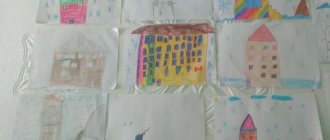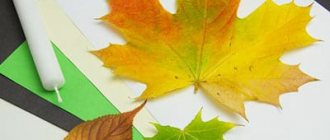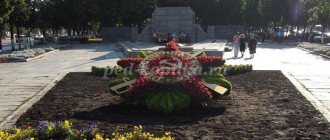MAGAZINE Preschooler.RF
Summary of GCD Topic: “My city”in educational field: cognitive development for middle group children
Slashcheva Lyubov Vladimirovna teacher of the highest qualification category MBDOU CRR kindergarten No. 5 “Fairy Tale” Work experience: 33 years Ozyory 2015 MUNICIPAL BUDGET PRESCHOOL EDUCATIONAL INSTITUTION CHILD DEVELOPMENT CENTER - KINDERGARTEN No. 5 “FAIRY TALE”
Age group: middle group.
Form of organization: group.
Goal: to clarify and consolidate children’s knowledge about their hometown - Ozyory, about the main attractions of their hometown. To form love and interest in the small Motherland.
Tasks:
Educational:
- expand and deepen children’s understanding of their hometown;
- clarify children's knowledge about their hometown through photographs and various activities;
Educational:
- develop memory, attention, thinking, observation;
- develop curiosity and cognitive activity in various activities;
- develop the ability to respond emotionally to what you read and see in life;
- consolidate knowledge of home address;
- develop coherent speech in preschool children, teach children to express their thoughts and reason;
- activate children's vocabulary: small Motherland, big Motherland, Ozerchan residents, sights.
Educational:
- cultivate a sense of pride and admiration for one’s hometown;
- to cultivate the desire and desire to take part in the improvement of our city.
Teaching methods
Practical (game situations);
Visual (illustrations, presentation);
Verbal (story, conversation,)
Techniques
- Techniques for setting goals and motivating children: the ability to choose a specific solution, focus on listening carefully and completing the task.
- Techniques for activating children’s activities during a thematic meeting: conversation, reading proverbs and sayings to the Motherland and hometown of Ozyory, reading a poetic text, playing the game “I live on ... floor” . “Radio broadcast” , treats, candies from the “Souvenir” , viewing illustrations, creating a problem situation, analysis and conclusions.
- Techniques for organizing children's practical activities: showing the method of action.
- Techniques for maintaining interest in children: physical education break, alternating types of children's activities.
- Methods of assessment and self-esteem: encouragement, mutual assistance of children,
*
Equipment and materials.
Demo material:
- multimedia presentation, photographs of city sights;
- slides of sights of the city of Ozyory;
Handout:
- sweets from the Souvenir .
Equipment:
- multimedia projector, screen, laptop;
- toy microphone, ball
Integration of educational areas:
- Cognition: To form in children an idea of Lakes as their hometown. To cultivate a feeling of love and pride for your small Motherland. Instill love for your small homeland. Expand knowledge about your hometown and its attractions. Recognize familiar places in photographs.
- Communication: Enrich your vocabulary (nouns, adjectives, verbs, adverbs). Clarify and activate your vocabulary. Develop coherent speech and logical thinking. Expand words knowledge. Reading literature: to form an emotionally positive attitude towards poems about the Motherland, hometown.
- Socialization: Form a friendly relationship between children and adults. Continue to work on your ability to listen to your comrades’ answers. Cultivate persistence in achieving a common goal, a sense of teamwork and mutual understanding
Previous work:
- walk along the nearby streets;
- reading and memorizing poems and proverbs about the Motherland, conversations about the city;
- viewing photographs and illustrations of the city’s attractions;
- photo exhibition of drawings by parents about their hometown. Design of the photo album “Nature of the native land” .
Interaction with parents:
- round table conversation with parents about the history of the city,
- demonstration of maps of the city of Ozyory (old and new), display and demonstration of photographs of the old and new city;
- preparation of a photo exhibition on the topic “My family and I are vacationing in the city .
The course of direct educational activities.
Our city is great and beautiful
Above the free Oka River.
And he is the best for us
Dear and dear.
Educator: children, I read you a poem about our hometown. Do you remember the name of our city?
Educator: what are we called, its inhabitants?
Educator: why do we say that Ozyory is our hometown?
Educator: How do you understand the word “Motherland” .
The word “Motherland” is similar to words such as native, relatives, relative. Who are we talking about? That's right, about moms, dads, brothers, sisters and other loved ones. We say these words, and they emanate warmth and comfort. Likewise, our Motherland is the place where we were born, where we live, where our home is, where our friends live, where we feel warm and comfortable. For us, this is our hometown. It’s good when people love their city, their homeland. From this love she becomes richer and stronger. Listen to how the Russian people talk about love for the Motherland in proverbs.
There is no land more beautiful than our Motherland
Whoever fights hard for his homeland is a true hero.
Look, children, how beautiful our city is. (Show slides with views of the city or photographs against the backdrop of city attractions).
There are a lot of beautiful multi-storey buildings in our city.
Let's play the game "I live on... floor"
“I live on ... floor” is played : Children stand in a circle, pass the ball to each other and say what floor they live on.)
People live in every house: adults and children. Adults go to work. They work to make our city even better. Children go to kindergarten and school.
Educator: Our city is very big. There are many streets, houses, a park, a stadium where people relax. Every person, especially a small child, should know his home address very well so as not to get lost in such a big city. Home address is the name of the city, street where you live, house and apartment number.
Let's play the game "Radio Broadcast"
(The game “Radio Broadcast” : Now you will have the opportunity to loudly announce your home address on the radio. You need to start with the words: “I live in the city... On the street... house number... apartment..." .
To play, use the “microphone” . Children take turns calling their home address; in case of difficulty, the teacher helps the child correctly state his exact address.)
Educator: Well done, children. You know your home address. What should you do if you suddenly get lost in a large store or in a park?
You need to approach a police officer or the seller, give your name, surname and home address. But we hope this doesn't happen to you.
You also need to know the address in order to receive letters from other cities, so that your guests know where to come on holidays, so that you can call a doctor at home if you suddenly get sick.
Educator: today we talked about our hometown, remembered interesting places ( Palace of Culture , Grinin Stadium , bus station, monument to fallen soldiers, music school, Souvenir )
But in our city there are many more wonderful places, I am sure that you will visit them all. Please tell me, what can you, little residents, do to make our hometown even more beautiful?
Educator: That's right, guys: don't litter on the streets, plant flowers in the spring on the kindergarten site, near the house, be friends with each other.
The teacher praises the children and distributes treats and candies from the Souvenir .
| Next > |
Summary of the educational lesson “My City”
My city
Cognitive lesson in the middle group
Tasks.
Continue to consolidate children’s knowledge about the name of their hometown and introduce it to its sights. Bring to the understanding that the people who built the city tried very hard and did their job well. Develop a sense of pride in your city
Material
. Slides with photographs of your hometown (at the teacher’s choice); photographs (city, village, several landscapes, park, square); an envelope with a cut-out picture “Assemble a new attraction for the park” (for each child).
Preliminary work.
Compiling the album “My City”, reading poems and stories about my hometown. A trip with parents to your favorite vacation spots in your hometown (square, children's park, beach, embankment, Sports Palace, museum, circus, etc.).
Progress of the lesson
The lesson begins with reading a poem about your hometown. Educator: “Guys, what do you think this poem is about? (About the city, about its beauties, about nature.)
What is our city famous for? Who lives in it? Do we live in a city, in a town or in a village?” (Children’s answers.)
Invite the children to look at the illustrations (a city, a village, several landscapes, a park, a square), and put aside those that depict the city. Children complete the task.
Educator: How did you guess that this was a city? (The city has many tall buildings, large streets; there is transport, a lot of people, a lot of shops.)
Right.
A place where many people live, where there are many streets and buildings, is called a city. There are a lot of cities, they are all different. Each city has its own name. For example, the main city of the Motherland is Moscow. If we live in a city, then who are we? (City residents, townspeople, Muscovites, Miass residents, etc.)
What are the people who live in the village called?
(Villages, village residents, etc.)
You have probably already visited many places beloved by city dwellers with your parents.
Tell us where you visited with your parents and what interesting things you saw in our hometown. (Children's stories.) What good words can you say about our city? (Beautiful, big, clean, ancient, young, cheerful, green, famous, etc.)
The teacher invites the children to go on a tour of their favorite city without leaving the group. He asks: “What can you use to travel around the city?” (By bus, car, trolleybus.)
At the request of the children, the type of transport they will “travel” is chosen.
The teacher invites the children to take seats in the transport. Children sit on chairs arranged in a row of two, slightly diagonally, for a better view of the photographs that the teacher will demonstrate.
Educator: We hit the road and drive through the streets of our city. (On the slide is a photograph of the main street.) What do you “see from the window? (Pay attention to the photo: there is a road on it, cars, buses are driving, a store is visible, a lot of people, etc.) What street is this? (Wide, large, paved.)
Or maybe some of you know the name of this street? (If the children don’t know, name the street.) We arrived at the first stop, a favorite place for the townspeople - a children’s park. (There is a photo of the park on the slide.) Do you like to visit a children's park? What's in this park? (Children's answers). The teacher invites the children to add new attractions to the children's park. To do this, you need to collect cut-out pictures (distribute envelopes with cut-out pictures to the children).
The game “Assemble a new attraction” is played.
When the children complete the task, the teacher asks each child: “What new attraction have you built? Where will it be located in the park? Offers to continue the journey through his hometown. (On the slide is the next photo, “Cinema”.)
Educator: What are they doing at the cinema? How many of you have been to the cinema? What films and cartoons did you watch? What is there in the cinema halls? How should you behave at the cinema? (Children's answers)
The tour of our hometown continues. Similarly, consider photographs of other objects.
Ask the children a few questions about each object and offer a game task: “Tell me what you know about this place”, “Find a familiar place in the city”, “What’s extra?” etc.
In conclusion, the teacher says: “Our beautiful city was created and built by people of different professions. They tried, they worked well, to make the city comfortable to live in, to make it very beautiful and big. If every resident does something good for the city, it will become even more beautiful.”
Literature used: “Acquaintance with the subject and social environment” by O.V. Dybina
Photos were selected on the Internet




